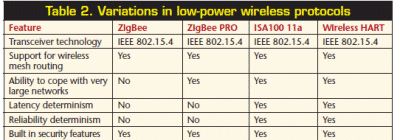Ultra-low-power wireless sensor networks require standards for market acceptance
BY CEES LINKS
GreenPeak Technologies
Utrecht, The Netherlands
http://www.greenpeak.com
Today we are entering the third wireless wave. Also known as “The Internet of things,” the third wave uses wireless sense and control technology to bridge the gap between the human physical world and the virtual electronic world.
Sense and control networks do not enhance human communication. Instead, they allow sensors to interact with actuators, creating a more dynamic world and avoiding error-prone, monotonous, and costly human labors.
Ultra-low-power wireless sensor networks can benefit many types of applications. These include monitoring temperature, vibrations, humidity, position, tank levels, and so on, in industrial plants which can be linked to the control and actuation of HVAC systems, storage, robot movements, or temperature control.
Examples abound. For one, agricultural applications benefit from wireless sensor networks via temperature sensors and soil-moist sensors that monitor fields, vineyards, and green houses and, automatically adjust irrigation and fertilization.
For many real-world applications, low-power wireless sensor networks will provide many advantages including the elimination of hard-wiring, enhanced flexibility in constricted or dangerous areas, ease of installation, increased safety, and reduced maintenance costs. However, the strength of wireless sensor networks can only be fully exploited when carried by industry standards.
Standards enable growth
Wireless communication prospers best within the space of industry standards. Standards provide OEMs and integrators the flexibility of second sourcing. They allow devices from different vendors to interoperate, a paramount feature in all major applications.
Sensor applications have very different requirements than most wireless networks, with power consumption probably being the most apparent difference. For wireless sensor transceivers, the dominant and probably only real standard is the IEEE 802.15.4 specification (ZigBee and other versions). Several vendors already offer transceiver chips based on 802.15.4. Some are a minimal implementation of the standard while others offer add-on features technologies that are useful for specific applications. For example, GreenPeak’s GP500 transceiver includes many power-reducing features that target coin-cell battery and energy-harvesting powered applications.
Table 1. A comparison of the main parameters of IEEE 802.15.4 and Bluetooth

There have been efforts to use Bluetooth and Wi-Fi for sensor applications. They were both used in a nonstandard way, adopting the principles of IEEE 802.15.4 in their native implementation. It is widely accepted that the IEEE 802.15.4 offers the best basis for low-power wireless sensor applications.
The impact of the ZigBee Alliance
The ZigBee Alliance is an independent standardization organization driven by a large group of technology providers and OEM companies. At the end of 2007, the alliance finalized the specification of network stacks for ZigBee and the ZigBee PRO.

ZigBee PRO’s extra features require a larger program memory size, which translates into higher cost. In the extremely cost-sensitive consumer market, every extra cost limits the likelihood of adoption. However, thanks to the ever-decreasing cost of silicon, we predict that in the short term the cost difference between ZigBee and ZigBee PRO will be negligible and that most applications will adopt ZigBee PRO.
ISA-100 and Wireless HART
ISA-100 and Wireless HART are two industrial wireless automation standards. ISA-100 is the brainchild of the Instrumentation, Systems, and Automation Society (ISA), a nonprofit technical society focusing on industrial automation. Wireless HART is not a full industrial sensor protocol, but an add-on to the old but popular HART industrial wired bus standard for industrial automation. As ISA-100 and Wireless HART are fundamentally solving the same problems, they are examining whether the standards can be merged.
Table 2. Variations in low-power wireless protocols

Proprietary wireless technology
Besides the IEEE 802.15.4 standard, a number of technology suppliers have chosen to build a proprietary transceiver. The main motivation seems to be a reduction of the complexity and thus a potential lower cost point.
A proprietary technology can develop much faster than a technology standard because there is no need to reach consensus among different companies. However, it remains to be seen if a proprietary solution will ever reach sufficient volumes to actually get a lower cost point. Also, reducing the complexity sometimes goes hand in hand with sacrificing performance and thus limits the applicability.
Recent evolutions
Even within the boundaries of standards, technology providers can discover differentiation opportunities. As one example, the GreenPeak Emerald GP500C transceiver and network stack technology is compliant to the IEEE 802.15.4 standard and adds functions for ultra low-power applications.
Another evolution that is likely to appear soon in standards is low-power routing (LPR). In an LPR network, battery powered devices are able to receive messages from nearby devices and forward these further down a longer communication chain. Other standards offer this functionality only for continuous powered devices, that need to be in a continuous listening state. LPR adds a time synchronization mechanism to the network, allowing devices to wake up simultaneously to initiate communication and avoiding the need to be always on.
The industry has been looking at standards for battery-less wireless networks. There are also a variety of ZigBee Specialized Profiles ZigBee subsets for specific functions. These smaller, more task-oriented, stacks consume less power. Specialized profiles for “Smart Energy” and “Home Automation” have already been developed and released. The new Battery-less profile is still in development and is expected to be completed in the first quarter. ■
Advertisement
Learn more about GreenPeak





